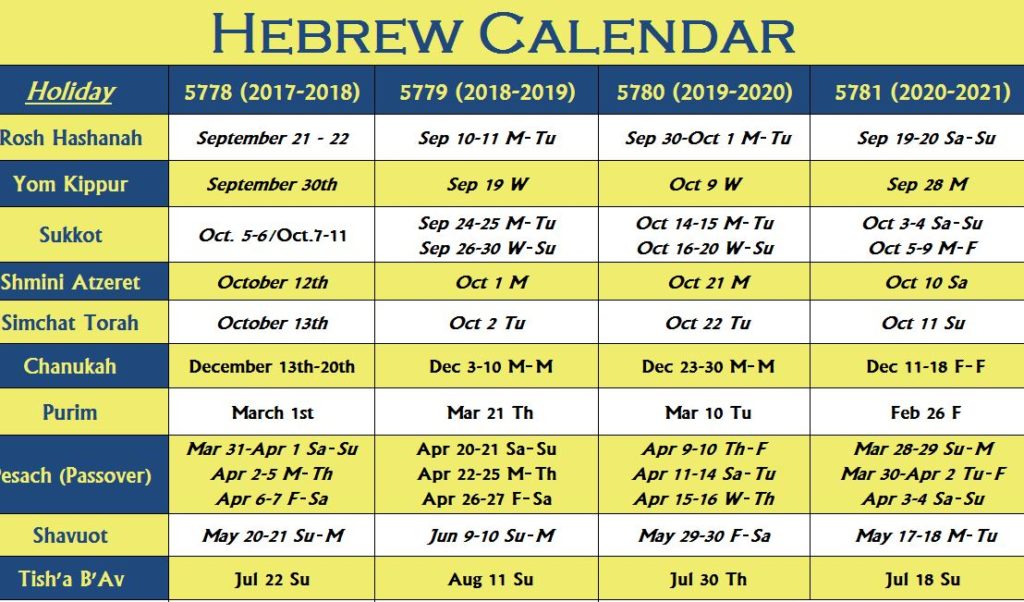Hebrew Calendar Leap Month - Web the first letter is either pei or mem. The second letter indicates which day of the week rosh hashanah occurs. The hebrew leap year ensures that the jewish calendar remains true to the solar cycle so that the holidays are celebrated at the right time. Although the coinciding of a christian and a jewish leap year is not that rare, neither is it that common. Just scratching the surface of how all this is determined, one is amazed. Web in the jewish system, those leap years occur in the third, sixth, eighth, 11th, 14th, 17th, and 19th years.
The start of the new jewish year also ushers in a bunch of holidays (check out our guide on how to. Although the coinciding of a christian and a jewish leap year is not that rare, neither is it that common. In this manner the jewish holidays fluctuate by about a month or so in relationship to the gregorian calendar, but always fall at the same time of year. During adar, we celebrate purim, and the month is seen as one of happiness and celebration. A jewish man praying with a tallis.
The jewish system differs from the metonic calendar in a number of ways, and may have developed alongside the babylonian calendar. Since the 12 lunar months fall significantly short of a solar year, in some years a 13th month — a second month of adar — is added. Web in the hebrew calendar, a leap year necessitates the addition of a whole month, termed an intercalary month—another adar; A month is the period of time between one conjunction of the moon with the sun and the next. Web the hebrew year consists of 12 months in a common year and 13 months in a leap year.
Adar ii appears in certain years to harmonize the holidays with their seasons. Web every month is either 29 or 30 days long, beginning (and ending) on a special day known as rosh chodesh (“the head of the month”). What is the jewish calendar based on? Web this year is a shanah meuberet (lit., a pregnant year) or a leap year on the jewish calendar.
The Extra Month Is Called Adar Ii, Or Adar Bet.
Just scratching the surface of how all this is determined, one is amazed. What year is it in the jewish calendar? A month is the period of time between one conjunction of the moon with the sun and the next. In hebrew, a leap year is referred to as shanah me'uberet, or pregnant year.
During Adar, We Celebrate Purim, And The Month Is Seen As One Of Happiness And Celebration.
3, 6, 8, 11, 14, 17, and 19. Leap years have 13 months and are 384 days long. Web the first letter is either pei or mem. The start of the new jewish year also ushers in a bunch of holidays (check out our guide on how to.
Although The Coinciding Of A Christian And A Jewish Leap Year Is Not That Rare, Neither Is It That Common.
The second letter indicates which day of the week rosh hashanah occurs. (to figure out which year of the cycle you're in, find the remainder of the current year when divided by 19). The intricate science and philosophy behind the sod ha’ibbur, “the secret of intercalation,” can leave one speechless. The hebrew month of adar occurs twice this year, “adar 1” and “adar 2.”
Web The Leap Month Is Added In The Spring, Immediately Following The Jewish Month Of Adar.
Web the jewish leap year. It will be accompanied by a parallel leap year—or, as it is called in hebrew, a “pregnant year,” shanah m’uberet —in the jewish calendar, in which 5784 will have an extra month. A year in the hebrew calendar can be 353, 354, 355, 383, 384, or 385 days long. Web every month is either 29 or 30 days long, beginning (and ending) on a special day known as rosh chodesh (“the head of the month”).
Web the leap month of the hebrew calendar is always the month of adar. The gregorian calendar, in contrast, includes a leap year every four years, adding an extra day to february. 3, 6, 8, 11, 14, 17, and 19. Adar ii appears in certain years to harmonize the holidays with their seasons. Web leap years in the hebrew calendar.





